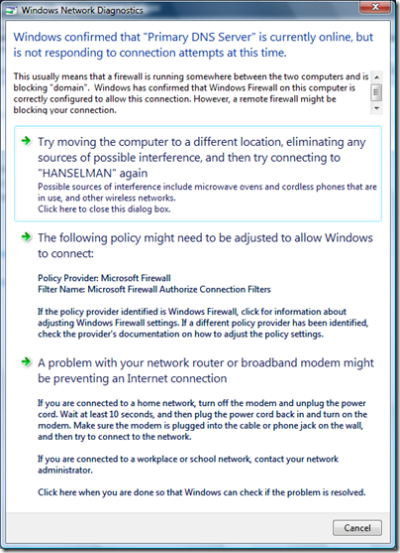TMI (To Much Information) Networking Dialog Box of the Day
This dialog box is a work of art, truly. ;) It filled the screen on a 1024x768 laptop. I've read through it, completely, four times, and I'm still not quite clear on what it's trying to tell me. One day I shall unlock its hidden secrets.
First, it took me a moment to realize that the choices were meant to be clicked on. They are neither buttons nor hyperlinks. The first choice just closes the dialog...doing nothing. Apparently I'm supposed to make sure my microwave is turned off.
The second one tries to be generic by saying "The following policy" in the first hard-coded sentence. Then the last paragraph actually references BACK to the list, forcing me (rather than the computer that actually has the information) to figure out if the "policy provider identified is Windows Firewall." If it wasn't, I'm to "check the documentation." Helpful. Really. Danke.
The third and longest "not-button-arrow-choice-action-clickable-area-thing" says I should unplug my home's Internet connection. Seems a little drastic if you have a spot on the carpet to lay down all new carpet. (Also, why do we insist on calling these routers "modems"? What exactly are they modulating and demodulating. Newsflash - It's not like I'm calling out to FidoNet every night on my USR v.32bis.)
I ended up right-clicking on the connection in the tray and selecting Diagnose and Repair and all was well. I also reveled in the fact that Diagnose and Repair was NOT available when using the much more common single-left-click on the network connection icon.
Oy, the networking in Vista is SO confusing. All I can count on is netsh (how-to).
Seriously, do yourself a favor and head over to a command prompt now and run...
netsh interface ip show config
...and experience a level of detail that ipconfig /all can't touch. (Which apparently doesn't work as Admin...bummer) You'll begin to appreciate why typing...
netsh interface ip set address "Local Area Connection" dhcp
...can make you look like a superstar whilst others are still clicking around.
About Scott
Scott Hanselman is a former professor, former Chief Architect in finance, now speaker, consultant, father, diabetic, and Microsoft employee. He is a failed stand-up comic, a cornrower, and a book author.
About Newsletter
What exactly are they modulating? The usual stuff - amplitude and phase, typically. Most ADSL systems use 'DMT' - Discrete MultiTone - which involves using a very large number of carrier frequencies. (I'm not sure how many ADSL typically uses, but broadcast digital video typically uses a similar scheme, and there it was common to have about a thousand carrier frequencies.) On each invididual carrier, phase and amplitude modulation is performed, in much the same way as good old-fashioned modems designed to work over the audio channel of a telephone connection.
So 'modem' is an exactly appropriate name.
This is what happened when I tried it on my default (non-admin) user:
C:\code>netsh interface ip show config
C:\code>
No information, no error message. Using ipconfig /all works just fine.
When I tried again with Runas administrator, netsh gave me the information I expected.
I'm assuming you are running as an admin without UAC on Vista. I wonder how many clicks you would truly save if you still had UAC on.
The networking on Vista is confusing and frustrating. After 6 months of fighting it on my tablet, I'm planning to re-image back to XP this weekend.
On the plus side, Aero Glass is nice... and slow.
802.11 devices are also RF modems, but branding took over the common public lexicon :)
ISPs which give you the "modem" call it a modem.
You can't seriously tell me that is more difficult to do than XP. You've added a CTRL-SHIFT and an ALT-C to the entire process. Is it more work? absolutely, four extra keys; is it harder work? this is coming from the same person who wants to type "netsh interface ip show config" on a command line? Please...
Progress - 3 steps forward 2 steps back. <s>
Comments are closed.


On why modems are called modems -- you're certainly right that the name means actually "modulator/demodulator". But, as a matter of tech slang, these terms are not necessarily meant to express digital/analog conversion; digital signal can be modulated into another format of digital signal, which is what happens when you plug your modem into, say, cable TV outlet. The signal is still digital; it's just another kind of digital.
BTW pity my English -- it's pretty much stillborn :/.